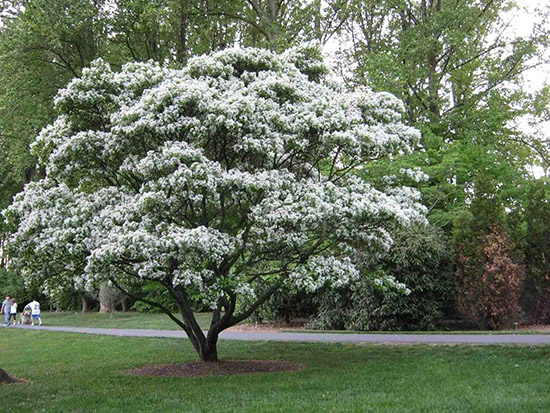Issue 13, August 3, 2015
Emerald Ash Borer
Emerald ash borer has been found in white fringetree in northern Illinois. Research conducted by Don Cipollini, Wright State University, Dayton, OH found characteristic exit holes, larval tunneling damage, or other symptoms in 7 of the 16 white fringetrees, Chionanthus virginicus, inspected at the Morton Arboretum on May 29, 2015. Dr. Cipollini conducted previous research in Ohio that proved by taxonomic examination and DNA analysis that emerald ash borer is able to infest and complete its life cycle in white fringetree.

White fringtree, Smithsonian garden.
He also conducted laboratory research on emerald ash borer attack. Emerald ash borer eggs hatch into larvae that proceed through four larval instars (stages) before forming prepupae, pupating, and emerging as adults. He found that eggs produced larvae that, after 40 days of developing in white fringetree, weighed one-third as much as those from green ash.
He also tested the closely related Chinese fringetree, Chionanthus retusus, and devilwood, Osmanthus americanus, as potential hosts. Of the 42 eggs placed on Chinese fringetree, all of them hatched into larvae that penetrated the stem, but none survived 40 days. All of the larval tunnels were one inch or less in length before the larvae died. Of the 30 eggs placed on devilwood, 24 hatched into larvae that penetrated the stem, with three surviving 40 days. Those surviving larvae weighed one-seventh as much as those from green ash. Their larval tunnels averaged about 20 inches long.
Both Chionanthus and Osmanthus are closely related to ash, Fraxinus. Of the three non-ash species, white fringetree is the only one found to support complete development of emerald ash borer to the adult stage. Based on his research and observations, Dr. Cipollini surmises that white fringetree is attacked by emerald ash borer when most of the ash trees in an area are dead and dying. That white fringetree is attacked by beetles that cannot find suitable ash trees on which to lay their eggs. White fringetree is apparently attacked in desperation and is not a primary host.
The research paper will be published in the journal, Environmental Entomology, and has been released via advanced access. A release on the research is located at http://phys.org/news/2015-07-white-fringetree-emerald-ash-borer.html. (Phil Nixon)
Author:
Phil Nixon